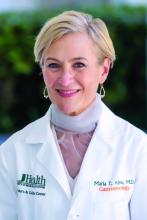Although it had been thought that incidence rates of IBD were plateauing in high-incidence areas, a Danish study found a steady increase in incidence of Crohn’s disease and ulcerative colitis (UC).1 The highest increase in rates occurred in children and young adults, which will have repercussions as people get older and contribute to higher compounding prevalence. We need to get better at dealing with other health conditions as patients get older. A very large prospective Spanish study found that 42% of IBD patients scanned consecutively had MAFLD (metabolic-associated fatty liver disease) – even if they didn’t have high BMI and type 2 diabetes, suggesting that systemic inflammation in IBD contributes to the development of metabolic liver disease.2
The AGA has recently published guidelines for using biomarkers in the management of UC. Patients with very low fecal calprotectin (FCP) are unlikely to have active disease whereas FCP over 150 with significant symptoms may warrant empiric changes in treatment.3
Intestinal ultrasound is gaining wider acceptance as a noninvasive way to monitor IBD.4 In a UC study, improvement in bowel wall thickness following tofacitinib treatment correlated well with endoscopic activity.5
The majority of the presentation focused on the explosion of Food and Drug Administration–-approved medications for IBD in recent years. S1P receptor agonists, such as ozanimod and etrasimod, may work by trapping specific T-cell subsets in peripheral lymph nodes, preventing migration to intestinal tissues. Ozanimod is approved for UC. Etrasimod showed efficacy in UC with clinical remission rates of about 27% at week 12 and 32% at week 52.6,7
There has been a lot of excitement about JAK inhibitors for IBD. Upadacitinib has recently been approved for both UC and Crohn’s disease. Response rates of 73% and remission rates of 26% were seen in UC patients who had been largely biologic exposed.8 Similar results were seen in a biologic-exposed Crohn’s disease population treated with upadacitinib including in endoscopy.9 Upadacitinib was effective in maintaining remission at both 15-mg and 30-mg doses; but the higher dose had a greater effect on endoscopic endpoints.10
For Crohn’s disease, we now have risankizumab, an anti-p19/IL-23 inhibitor. Risankizumab was efficacious at inducing and maintain remission in the pivotal phase 3 studies, even with 75% of patients being biologic exposed. These studies used combined endpoints of clinical remission as well as endoscopic response.11 Guselkumab (anti-p19/IL-23) is also being studied for Crohn’s disease and early trials has appears to be efficacious.12
A head-to-head study of naive CD patients treated with ustekinumab or adalimumab (SEAVUE) showed comparable rates of clinical remission. At 52 weeks, the rates of clinical remission were quite high: >60% and endoscopic remission >30% with either therapy.13
We now have phase 3 data showing that a biologic is efficacious in patients with chronic pouchitis. The EARNEST trial demonstrated that vedolizumab has efficacy in treating pouchitis with improved clinical symptoms and endoscopy.14 Future treatment strategies may involve combinations of biologic therapies. The VEGA study showed that combining an anti-TNF, golimumab, with an anti-IL23, guselkumab, was superior than either alone with respect to clinical remission and endoscopic improvement in UC.15 We will see more studies combining therapies with diverse mechanisms of action.
In summary, there have been many noteworthy advances in treatment and management of IBD in the past year.
DDW is sponsored by the American Association for the Study of Liver Diseases (AASLD), the American Gastroenterological Association (AGA), the American Society for Gastrointestinal Endoscopy (ASGE) and The Society for Surgery of the Alimentary Tract (SSAT).
Dr. Abreu is director of the Crohn’s and Colitis Center and professor of medicine, microbiology, and immunology at the University of Miami. She is president-elect of AGA. Dr. Allegretti is director of the Crohn’s and Colitis Center and director of the fecal microbiota transplant program at Brigham and Women’s Hospital, Boston. She is associate professor of medicine at Harvard Medical School, Boston. Dr. Loftus is the Maxine and Jack Zarrow Family Professor of Gastroenterology, codirector of the advanced IBD fellowship in the division of gastroenterology and hepatology at Mayo Clinic, Rochester, Minn. Dr. Ungaro is associate professor of medicine at the Icahn School of Medicine at Mount Sinai, New York.
References
1. Agrawal M et al. Gastroenterology. 2022;163(6):1547-54.e5.
2. Rodriguez-Duque JC et al. Clin Gastroenterol Hepatol. 2023;21(2):406-14.e7.
3. Singh S, et al. Gastroenterology. 2023;164(3):344-72.
4. de Voogd F et al. Gastroenterology. 2022;163(6):1569-81.
5. Sandborn WJ et al. N Engl J Med. 2017;376(18):1723-36.
6. Sandborn WJ et al. N Engl J Med. 2021;385(14):1280-91.
7. Sandborn WJ et al. Lancet. 2023 Mar 25;401(10381):1000]. Lancet. 2023;401(10383):1159-71.
8. Danese S et al. Lancet. 2022 Sep 24;400(10357):996]. Lancet. 2022;399(10341):2113-28.
9. Loftus EV Jr et al. N Engl J Med. 2023 May 25;388(21):1966-80.
10. Panes J et al. Am J Gastroenterol 2022;117(S10). Abstract S37.
11. D’Haens G, et al. Lancet. 2022;399(10340):2015-30
12. Sandborn WJ et al. Gastroenterology. 2022;162(6):1650-64.e8.
13. Sands BE, et al. Lancet. 2022;399(10342):2200-11.
14. Travis S et al. N Engl J Med. 2023;388(13):1191-1200.
15. Feagan BG et al. Lancet Gastroenterol Hepatol. 2023;8(4):307-20.






